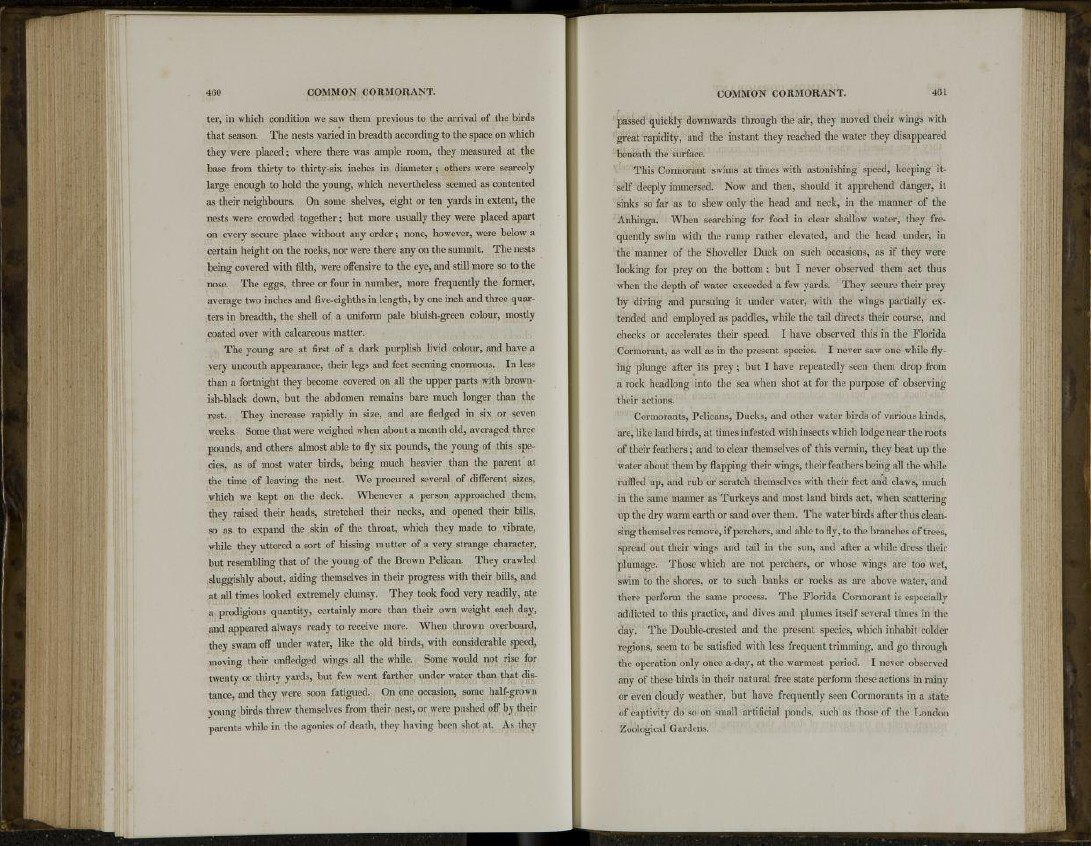
ter, in which condition we saw them previous to the arrival of the birds
that season. The nests varied in breadth according to the space on which
they were placed; where there was ample room, they measured at the
base from thirty to thirty-six inches in diameter; others were scarcely
large enough to hold the young, which nevertheless seemed as contented
as their neighbours. On some shelves, eight or ten yards in extent, the
nests were crowded together; but more usually they were placed apart
on every secure place without any order; none, however, were below a
certain height on the rocks, nor were there any on the summit. The nests
being covered with tilth, were offensive to the eye, and still more so to the
nose. The eggs, three or four in number, more frequently the former,
average two inches and five-eighths in length, by one inch and three quarters
in breadth, the shell of a uniform pale bluish-green colour, mostly
coated over with calcareous matter.
The young are at first of a dark purplish livid colour, and have a
very uncouth appearance, their legs and feet seeming enormous. In less
than a fortnight they become covered on all the upper parts with brownish
black down, but the abdomen remains bare much longer than the
rest. They increase rapidly in size, and are fledged in six or seven
weeks. Some that were weighed when about a month old, averaged three
pounds, and others almost able to fly six pounds, the young of this species,
as of most water birds, being much heavier than the parent at
the time of leaving the nest. We procured several of different sizes,
which we kept on the deck. Whenever a person approached them,
they raised their heads, stretched their necks, and opened their bills,
so as to expand the skin of the throat, which they made to vibrate,
while they uttered a sort of hissing mutter of a very strange character,
but resembling that of the young of the Brown Pelican. They crawled
sluggishly about, aiding themselves in their progress with their bills, and
at all times looked extremely clumsy. They took food very readily, ate
a prodigious quantity, certainly more than their own weight each day,
and appeared always ready to receive more. When thrown overboard,
they swam off under water, like the old birds, with considerable speed,
moving their unfledged wings all the while. Some would not rise for
twenty or thirty yards, but few went farther under water than that distance,
and they were soon fatigued. On one occasion, some half-grown
young birds threw themselves from their nest, or were pushed off by their
parents while in the agonies of death, they having been shot at. As they
passed quickly downwards through the air, they moved their wings with
great rapidity, and the instant they reached the water they disappeared
beneath the surface.
This Cormorant swims at times with astonishing speed, keeping itself
deeply immersed. Now and then, should it apprehend danger, it
sinks so far as to shew only the head and neck, in the manner of the
Anhinga. When searching for food in clear shallow water, they frequently
swim with the rump rather elevated, and the head under, in
the manner of the Shoveller Duck on such occasions, as if they were
looking for prey on the bottom; but I never observed them act thus
when the depth of water exceeded a few yards. They secure their prey
by diving and pursuing it under water, with the wings partially extended
and employed as paddles, while the tail directs their course, and
checks or accelerates their speed. I have observed this in the Florida
Cormorant, as well as in the present species. I never saw one while flying
plunge after its prey ; but I have repeatedly seen them drop from
a rock headlong into the sea when shot at for the purpose of observing
their actions.
Cormorants, Pelicans, Ducks, and other water birds of various kinds,
are, like land birds, at times infested with insects which lodge near the roots
of their feathers ; and to clear themselves of this vermin, they beat up the
water about them by flapping their wings, their feathers being all the while
ruffled up, and rub or scratch themselves with their feet and claws, much
in the same manner as Turkeys and most land birds act, when scattering
up the dry warm earth or sand over them. The water birds after thus cleansing
themselves remove, if perchers, and able to fly, to the branches of trees,
spread out their wings and tail in the sun, and after a while dress their
plumage. Those which are not perchers, or whose wings are too wet,
swim to the shores, or to such banks or rocks as are above water, and
there perform the same process. The Florida Cormorant is especially
addicted to this practice, and dives and plumes itself several times in the
day. The Double-crested and the present species, which inhabit colder
regions, seem to be satisfied with less frequent trimming, and go through
the operation only once a-day, at the warmest period. I never observed
any of these birds in their natural free state perform these actions in rainy
or even cloudy weather, but have frequently seen Cormorants in a state
of captivity do so on small artificial ponds, such as those of the London
Zoological Gardens.